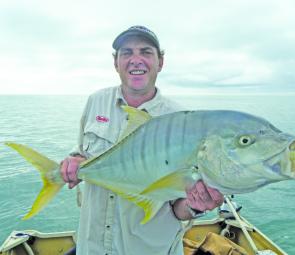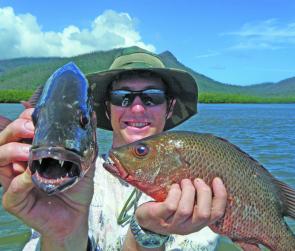If all is going to plan, when September rolls around we should be greeted with some of the best weather of the year.
Lucinda, and pretty much all of Far North Queensland’s weather over winter is dominated by persistent southerlies that blow like clockwork.
But around about this time of year it is really time to make sure you are prepared for heading out wider and getting amongst the reefies or heading up the channel in search of barra and jacks. Oh yes, here in Lucinda we are blessed to have such an amazing playground in our backyard.
The warmer weather and even some humidity will be making you sweat, and the fishing action should be full on with the barra and jacks really starting to get active as the water is getting warmer.
Many people wonder why they don't catch many barra when they are fishing with live baits. On closer inspection they are normally fishing with a less productive trace rig, with a sinker, swivel, trace and hook. The best two rigs to use are a paternoster or a float rig, as these two rigs have the bait off the bottom and away from the pickers and right where barra hold and hunt.
Barra have eyes on the top of their head and hunt looking up, so if the bait is on or close to the bottom the barra have a much harder time finding the bait.
I have been using floats with great results and the method is really simple. Get yourself some live bait such as mullet, whiting or large prawns. As a rule, the larger the bait the bigger the fish you will likely encounter. Barra have huge mouths and will try to eat anything they can fit in their gobs and a big live bait is almost irresistible to a barra.
Find a spot that offers some deeper water like a hole in the creek and some kind of structure along the bottom. The few hours before and after low tide is the best time as this is when the fish are active and hunting. Try to locate good structure on the bottom that has bait or fish hanging around it or, if unable to do this, find a big snag that you can see. Anchor up current from the area so you can float your bait with the current over the structure or into the snag. You want the bait to be around a meter or so off the bottom, which can be done by measuring out this distance under the float.
This method also is deadly using half pilchards or mullet fillets for jacks. Just float the baits into the snags and hang on. As soon as the float disappears make sure you strike and get some line on your reel or it’s game over.
If the wind allows it the reef will be alive with all sorts of goodies. The water will be starting to warm and the mackerel will be in plentiful numbers as they attack the big bait schools. Around the islands there will be some big Spaniards being caught by using live baits or trolling large gar or wolf herring. Out on the reef there will be plenty of smaller mackerel and it always pays to have a pilchard floating out the back whenever you are drifting or anchored up. A floating pilchard or a live bait could have all manner of species hitting the deck. It’s best to use a wire trace as bite offs are otherwise unavoidable. Make your own wire trace as most pre-made traces are not up to the standards when battling large fish.
This time of the year is also great for chasing all kinds of fish along the edges of the reefs using poppers and plastics. This type of fishing is great if kids are involved as it gets them active and offers an amazing visual aspect. Any of the reefs offer edges and bommies, but Britomart Reef is one of the best. A clear day and light wind will mean you can watch fish dart out and smash your offering. Just remember that some serious fish can be caught using this method, so use gear that allows for some fun but also allows you to put the brakes on if you need it.
Squid are always on the cards so always have a rod rigged up with a squid jig when playing around the reef or islands as sometimes you only have a short window before they spook. Fresh squid is always a welcome addition to the icebox or sending them back down with a hook through them.
Recently we have been catching some great golden trevally around the many creek mouths that offer sand banks with yabbies. Lucinda offers kilometres of perfect flats fishing for various fish including permit. Using stealth with the electric or just using the wind or current to push you over the flats while you throw lures, plastics or flies is a great way to fish on the incoming tide. Most of the goldens are sight cast to and when you see a big tale slapping around on the surface it really gets the adrenalin pumping. The best thing is fighting these fish over clean ground on light line as they race through the shallow water with a speed that surprises just about everyone.
Reads: 3695
September, sun, sand and flats of gold.

Keep a firm grip on your rod, it's Jack time.




